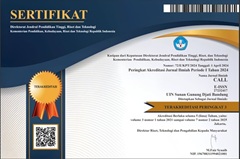SOCIAL DEIXIS ANALYSIS IN THE FINAL INTERVIEW WITH THE OBAMAS
DOI:
https://doi.org/10.15575/call.v3i1.12833Abstract
The final interview with Obama, as one of influential persons in the world, attracted many media to broadcast. His interview showed real-life interaction of a representative figure so that the way he used language is also representative. Specifically, this study aims at finding out the kinds of social deixis and to describe the function of social deixis in The Final Interview with the Obamas. The data are analyzed in a qualitative descriptive method to point out the phenomena of social deixis in the news as a part of daily life and since the collection of the data are mostly analyzed by using description and explanation form which focus on the characteristics, types, and the reason why the usage of social deixis is the main issues to be investigated. Based on the analysis of The Final Interview with The Obamas from the PeopleTV YouTube channel, it can be concluded that all types of social deixis according to Levinson’s theory are found in the object of research. There are relational which manifested by the speaker and referent, the speaker and addressee, the speaker and bystander, and the speaker and setting. There is also absolute social deixis which is manifested by the authorized speaker, and the authorized recipient absolute social deixis. In addition, the three functions of social deixis are also found in the utterances in The Final Interview with The Obamas. Those are the social status differentiation function, politeness function, and social identity function.
Â
Keywords: Social Deixis; Interview; Pragmatics
References
_B.Hill, D. R. (1987, August 2). Ebony . The New Black Middle Class, p. 30.
_Cahyono, B. Y. (1995). Kristal-Kristal Ilmu Bahasa. Surabaya: Airlangga University Press.
_Dane, F. (1990). Research Methods. California: Brooks/Cole Publishing Company.
_Kreidler, C. (1998). Introducing English Semantics. London&NewYork: Routledge.
_Leech, G. N. (1983). Principles of Pragmatics. London: Longman.
_Levinson, S. (1983). Pragmatics. Cambridge: Cambridge University Press.
_Purwo, B. K. (1990). Pragmatik dan Pengajaran Bahasa: Menyibak Kurikulum 1984. Yogyakarta: Kanisius.
_Rachmanita, A. A. (2016). Deiksis Sosial dalam Novel Sang Pemimpi Karya Andrea Hirata dan Implikasinya terhadap Pembelajaran Bahasa dan Sastra Indonesia di SMP Unpublished paper. Jakarta: Fakultas Ilmu Tarbiyah dan Keguruan, Universitas Islam Negeri Syarif Hidayatullah Jakarta.
_Rahardi, K. (2005). Pragmatik: kesantunan imperatif bahasa Indonesia. Jakarta: Penerbit Erlangga.
_Wijana, I. P. (1996). Dasar-Dasar Pragmatik. Yogyakarta: Penerbit Andi Ofset.
_Yule, G. (1996). Pragmatics. New York: Oxford University Press.
Downloads
Published
Issue
Section
Citation Check
License
Authors who publish in CALL agree to the following terms:
- Authors retain copyright and grant the journal right of first publication with the work simultaneously licensed under Attribution-ShareAlike 4.0 International (CC BY-SA 4.0) License that allows others to share the work with an acknowledgment of the work's authorship and initial publication in this journal.
- Authors are able to enter into separate, additional contractual arrangements for the non-exclusive distribution of the journal's published version of the work (e.g., post it to an institutional repository or publish it in a book), with an acknowledgment of its initial publication in this journal.
- Authors are permitted and encouraged to post their work online (e.g., in institutional repositories or on their website) prior to and during the submission process, as it can lead to productive exchanges, as well as earlier and greater citation of published work (See The Effect of Open Access).




